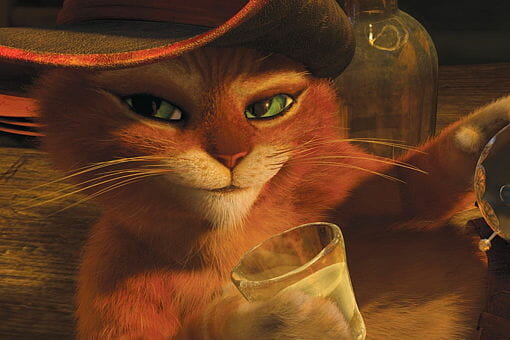By Sunny Choi · October 31, 2011

Everyone loves Puss (Antonio Banderas), including people who dislike Shrek. If you don’t find him irresistible, especially when he’s daintily licking up milk or begging for mercy with those googly-eyes, you must be a heartless person. Despite his small stature, he exudes charisma as he outmaneuvers foes with outstanding swordsmanship and feline grace. Fusing adorable, adventurous fluff with down-to-earth discussions about friendship and individual choice, Puss in Boots will appeal to both older and younger audiences.
Puss, the womanizing, mischievous outlaw, sets out to steal magic beans from evil giants, Jack (Billy Bob Thornton) and Jill (Amy Sedaris). After he is rudely interrupted by Kitty Softpaws, the feline seductress (Salma Hayek), he encounters Humpty Alexander Dumpty (Zach Galifianakis), his traitorous former best friend. Humpty enlists Puss’ help to carry out this major heist. Against his better judgment, Puss (blinded by Kitty) agrees to help the seemingly remorseful egg.
To my surprise, Puss in Boots holds its own without making any references to Shrek’s characters or setting. By further exploring Puss’ personal history and quirks, the movie successfully establishes Puss as the center of the narrative. As an improvement from the third and fourth Shrek movies, this movie largely withholds adult humor and cheap pop culture jokes. This helps them target a younger audience and stick to its PG rating.
Unlike its last two predecessors, the movie discusses serious topics, such as the difficulty of forming one’s identity. As the only nonhuman orphans in the orphanage, Humpty and Puss reach out to one another and become “brothers.” In order to transcend their rootless, lonely existence, they aspire to find magic beans that will lead them to the golden goose. Humpty yearns to be with other eggs, and Puss just wants to be friends with Humpty.
Through its compelling use of flashbacks, Puss gives significant dimension to its villain, the troubled Humpty, who is morally and emotionally crippled by his lack of identity. The third and fourth Shrek movies portrayed the villain as totally reprehensible and absolutely deserving of punishment. While we occasionally wish to take a crack at Humpty, we come to empathize with his rootlessness as an orphaned talking egg. One of Humpty’s lines really touched me: “I’m not really food or a human.” As most of us end up reevaluating and reinventing ourselves, we can relate to Humpty’s identity crisis.
As Humpty succumbs to a bitter life of greed and thievery, Puss chooses the more just and honorable route and remembers to give back to his community. By showing this dichotomy, the movie empowers its young audience by reminding them that they can exert control over their lives to make good choices, regardless of age, background, or income. We can always improve our station by choosing the right path.
While this animation film uniquely features Latino and Hispanic characters as heroes, it often still depends on racial and regional stereotypes for characterization. This only imparts false stereotypes to children. As for reinforcing racial and regional stereotypes, the characters with Spanish accents all live in the desert. Hokey Latin guitar music often accompanies Puss’s heavily accented speech. Furthermore, in order to most easily vilify Jack and Jill, the movie portrays them as violent, obese southern hicks that coddle their ten baby hogs.
The movie also perpetuates gender stereotypes. Kitty manipulates her sexual wiles to seduce and entrap Puss. Mesmerizing Puss with her grace and beauty, she manages to pick pocket him at least three times. This only furthers the stereotype of the sly foreign woman manipulating her body and curves to get what she wants. Because the primary niche audience consists of children, this further engrains in their minds that people of certain race and gender tend to act this way.
On a lighter note, the CGI beautifully portrays not only the burgeoning beanstalk but also the land of the clouds and the rainforest. Dreamworks superbly plays upon its own strengths, especially for the flying sequences. While the musical score was not impressive for the most part, Puss and Kitty engage in a well-choreographed dance showdown in an underground kitty nightclub. They tap for rhythm, swing their hips, and nimbly patter across the stage. The split screen ingeniously showcases different alley cats creating music, by various means of stroking a fish bone, shaking a wine bottle with pebbles, and strumming a beat-up guitar. In this manner, it pays homage to the opening scene of West Side Story, as each small movement contributes to the scene’s overall music.
Despite some of its flaws, young families and cat lovers will adore this adventurous film. You don’t need to be a fan of Shrek to enjoy it. I, for one, would choose this film over some formulaic action or horror flick even for the warm, fuzzy emotional affect.